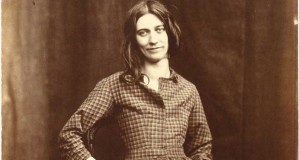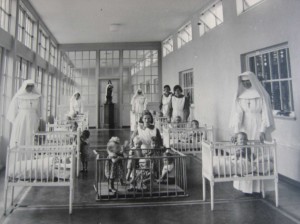Ar intinn eile – Ireland’s lost babies
Published in Issue 6 (November/December 2014), Reviews, Volume 22Blinder Films
TG4, 17 and 24 September and 1 October
BBC1, 17 September
RTÉ1, 18 September
By John Gibney
![Detail from The interior of Bedlam [London] from A Rake’s Progress by William Hogarth (1763). Jonathan Swift had been its governor long before making his bequest for ‘a house for fools and mad’ in Dublin. (McCormick Library, Northwestern University).](https://www.historyireland.com/wp-content/uploads/2014/10/The_interior_of_Bedlam_NEW-300x161.jpg)
Detail from The interior of Bedlam [London] from A Rake’s Progress by William Hogarth (1763). Jonathan Swift had been its governor long before making his bequest for ‘a house for fools and mad’ in Dublin. (McCormick Library, Northwestern University).
What is mental illness? To ask that question implies the existence of mental health, an intriguing definition of which was provided by Jim Lucey early in the first episode of Ar intinn eile: ‘the successful integration of human functions’. The three episodes of Ar intinn eile (An Irish state of mind) dealt with the treatment of mental health in Ireland over the past 300 years, and did so with the assistance of a wide range of expert opinion, both historical and medical; the presence of the latter pointed to the enduring relevance of the subject-matter.
This assured and revealing series was an account of a universal phenomenon explored through its Irish manifestations. ‘Madness’ has been a motif in Irish tradition for centuries, most notably in the twelfth-century text Buile Suibhne. Until the eighteenth century the mentally ill were often detained at home, in societies in which states were not expected to provide a safety net for illness of any kind. When it came to mental health, paradigms of diagnosis that had been inherited from classical Greece (and which were often intertwined with a good dollop of superstition) were eventually overturned by figures such as the philosopher John Locke, as it was increasingly recognised and accepted that mental illness could be amenable to treatment. The most famous Irish instance of this came from Jonathan Swift, who had been governor of London’s infamous Bedlam long before making his bequest for ‘a house for fools and mad’ in Dublin. Ireland possessed six asylums by the end of the eighteenth century and witnessed a massive expansion in their numbers prior to the Great Famine—the mark of a more interventionist state. The reasons for admission were remarkably varied: alcohol, the 1798 rebellion and ‘religious excitement’ were all seen as reasons for a massive increase in admissions to the Cork asylum in the decades after 1800. Yet mental illness was diagnosed under extremely broad headings such as ‘mania’ or ‘melancholy’, and this latitude posed its own problems. Very often the basis for committal was judicial rather than medical, and the grounds for diagnosis—especially for women—were often spurious.

A nineteenth-century asylum patient. Very often the basis for committal was judicial rather than medical, and the grounds for diagnosis—especially for women—were often spurious.
The existence of various forms of mental illness was and is no myth, and the series sought to probe some distinctive Irish reasons for their prevalence at certain times: the impact of famine, emigration, poverty and language shift may all have taken a toll that was psychological as much as physical. Dutch research into famines in the low countries in the 1840s points to links between malnutrition and mental health; children whose mothers had been seriously malnourished during pregnancy seem to have been more susceptible to disorders such as schizophrenia. The relevance of this to Ireland in the same period should be obvious. With regard to emigration, in 1854 some 53% of asylum inmates in Massachussets were Irish; such emigrants, having endured a traumatic, radical and irreversible change in the worlds in which they lived, may have had difficulty grappling with modernity in the US and ended up in captivity (their recourse to alcohol was noted by the authorities at the time and was arguably another symptom of trauma and dislocation).
The network of Irish asylums expanded dramatically in the decades after the Famine. Indeed, poverty made asylums attractive to the poor as a means of subsistence; they carried less of a stigma than workhouses, and the system had 12,000 inmates by 1891. Arguably, they had come to acquire an enduring role as a safety valve for Irish society. Genetics, masturbation and intemperance were all commonly instanced among the reasons for incarceration in Irish asylums, and the outbreak of the First World War saw shell-shock and syphilis added to the list (those suffering from the latter were deliberately infected with malaria in a macabre treatment: the ensuing fever was intended to kill the bacteria before the patient, and sometimes did).

Eoghan Harris—provided a forthright account of the experience of mental illness. (Kennedy Summer School)
The asylum system persisted into the 1920s in an Irish Free State with more pressing priorities and became integral to dealing with day-to-day social problems, often in a manner that ranged from the disturbing to the horrific. Legislation that had remained unchanged since the 1860s had, by the end of the Emergency in 1945, seen the number of inmates increase to 17,000 in institutions that were increasingly and frequently damned as unfit for purpose. Their integral role in Irish life is testified to by the colloquial term ‘around the bend’—a reference to the standardised design of the buildings. The testimony of those who were subjected to treatment in such institutions was, perhaps inevitably, largely absent, though some forthright accounts of the experience of mental illness were provided by a number of figures, notably Eoghan Harris. This elegant and understated series, written by Virginia Gilbert and directed by Brian Culleton and Irina Maldea, offered an impressive insight into a slice of Irish social history that, all too often, has remained hidden. It also adds to our pool of knowledge on what has been termed Ireland’s institutional ‘architecture of containment’, in which were confined those deemed troublesome, unwanted and embarrassing.

The nursery at Sean Ross Abbey mother-and-baby home, Roscrea, Co. Tipperary. Perhaps 40–60,000 children were ‘given up’ for adoption from such institutions. (Brian Lockier/Adoption Rights Alliance)
In 2011 the late Mary Raftery visited this territory in Behind the walls, her final documentary series on the history of psychiatric hospitals, and spoke of ‘our addiction to locking people away’ in institutions run by both the Catholic Church and the state. It has become painfully obvious that the boundary between these two categories was vague, to say the least, a point also emphasised in Ireland’s lost children, in which Martin Sixsmith revisited the territory he originally explored in the case of Philomena Lee: the enforced adoptions of Irish children born out of wedlock and subsequently seized from their mothers. Perhaps 40–60,000 children were ‘given up’ for adoption in this way, and very often these children were sold on for a tidy sum: these ‘adoptions’ led to a lucrative trade in babies being trafficked to the US, a trade facilitated by an Irish state that willingly provided passports to get them out of the country (the fact that there were instances in which some children were delivered into the hand of paedophiles in the US is extraordinary). The callous and wilful obstruction of attempts by both children and parents to contact one another by the Catholic orders that oversaw this was equally shocking. One might argue that these revelations are nothing new. But the ramifications remain ever-present in the lives of those affected by the warped morality and wilful abuse of power by church, state and society that created this dreadful chapter of recent Irish history, the authors of which have yet to be held to account in any meaningful way.
John Gibney is editor of www.decadeofcentenaries.com.
















